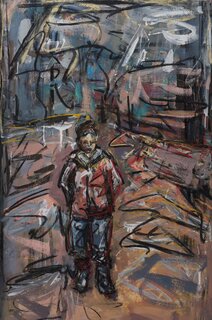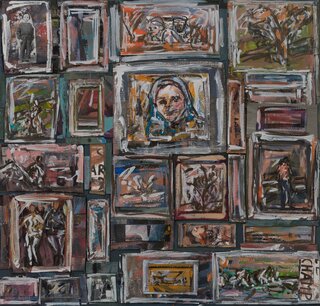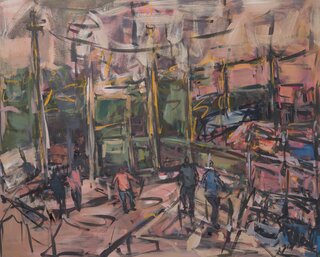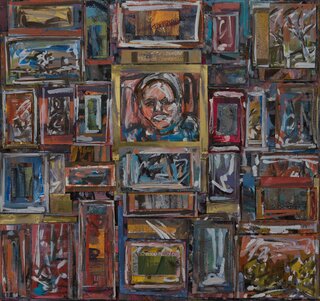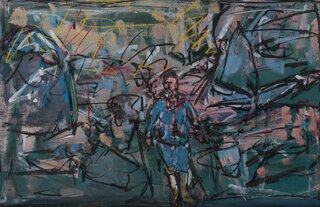
© Barnett Freedman estate
This unfinished painting was commissioned while Barnett Freedman was working as an Official War Artist during the Second World War and documents Allied preparations for D-Day in the War Room of the Portsmouth Army Base. was made a War Artist in 1940, serving first with the British Expeditionary Force in France (alongside illustrators Edward Ardizzone and Edward Bawden), and then with the Admiralty until 1946, when he was awarded the CBE for his war work. This included large-scale paintings, portraits of entire ships’ crews and a lithograph of the 15-inch Gun Turret in HMS Repulse. After the war, he became a TV and radio personality and was a supporter of Ben Uri, opening the 1946 collection exhibition and addressing an audience in 1947 on the subject of ‘The Artist To-day’, claiming that ‘for the first time in history there was no such thing as a starving artist’, either in painting, music or literature. His work was also included in the 1948 Spring exhibition. Freedman was made a Royal Designer for Industry in 1949.
Barnett Freedman was born in London’s East End to Russian-Jewish immigrant parents. Between the ages of nine and thirteen, he was confined by ill health to the London Hospital and worked afterwards as a signwriter, stonemason’s assistant and architect’s assistant, latterly attending evening classes at St. Martin’s School of Art. Through the intervention of Sir William Rothenstein he won the London County Council Scholarship and studied at the Royal College of Art (1922–25) under Paul Nash, himself an Official War Artist during both wars. In 1928 Freedman became a still life instructor at the RCA and later taught at the Ruskin School of Art, Oxford, under Albert Rutherston (Rothenstein’s younger brother). He held his first exhibition at the Bloomsbury Bookshop in 1929 and his realist style in this period is linked to that of the Euston Road School. Freedman afterwards became well-known for his commercial illustration and poster work for notable clients, such as the London Underground, and carried out a number of commissions in this post including designing publicity for Shell, the BBC and the General Post Office and Ealing Films. In 1935 he designed the George V Silver Jubilee postage stamp.
Freedman also became a successful and prolific book illustrator and book jacket designer. His illustrations include work for Faber and Faber, such as Siegfried Sassoon’s Memoirs of an Infantry Officer (1931), The Folio Society, and the Baynard and Curwen Presses. Using pen and chalk for reproduction by line blocks for black and white and auto-lithography for colour, Freedman developed an immediately recognisable style. He also became a distinguished letterer and typographer.
This is one of eight works in the Ben Uri Collection, seven of which were presented by the artist’s son, Vincent Freedman, in 2010. A companion piece, Soldiers in Town, 1944 (also unfinished) depicts off-duty Allied soldiers walking through a Northern French town. The seemingly relaxed atmosphere with children playing around them perhaps anticipates the end of the war.

